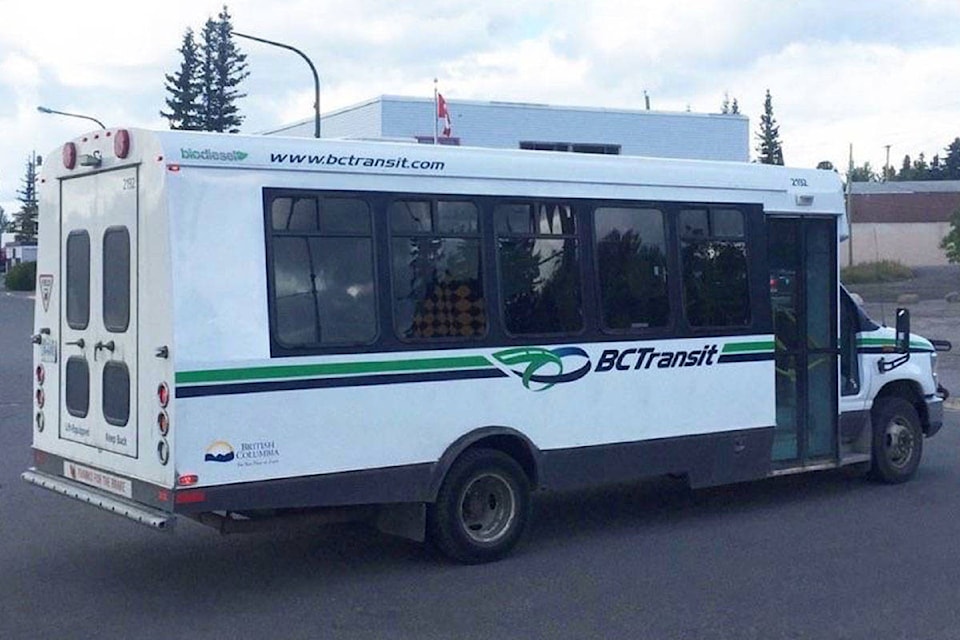Local governments were left debating the future of Boundary Transit last month after it was revealed that the service is facing a large financial shortfall for the coming year and needs more operating money in order to continue to run.
According to a series of memos presented to the Regional District of Kootenay Boundary board of directors in 2017, and discussion at a recent City of Grand Forks Committee of the Whole meeting, the Boundary Transit service needs additional funding to continue to operate at its current service level next year.
Last year the service was supplemented with additional funding from the RDKB rural areas, as well as the City of Grand Forks.
The Service
The Boundary Transit service is an on-demand bus service that runs within the city and RDKB Area D and to Greenwood. It provides door to door service for riders with mobility issues, and curb to curb service for all other patrons.
According to RDKB Chief Administrative Officer Mark Andison, the service is a partnership between local governments (the RDKB and the Cities of Grand Forks and Greenwood) and BC Transit.
Local governments pay a total of 38 per cent of the operating cost of the service. This largely comes from a $40,000 tax requisition, which was approved in 1991 at the formation of the service. It is codified in a bylaw.
The service is then subcontracted out for operation. In this case, it is subcontracted to Interior Health. Andison said while that arrangement is atypical (it is usually subcontracted to a private company) speaks to the type of service it is and its role in the community.
The fares for the service are relatively low at just $1.50 in Grand Forks and $1.75 to Greenwood. According to an RDKB memo, it operated about 2,000 service hours last year. Andison said that door-to-door service increased by about 11 per cent last year, and there are requests from the public for more and extended service.
“The problem is we have run into a situation where through the requisition limit of $40,000 cannot cover the cost of running the service. The requisition limit has been in place since 1991,” Andison said.
The Regional District of Kootenay Boundary
“For 2018 there will again be a need to address how the service will operate, and at what service levels, given the current requisition limit of $40,000,” a Nov. 2 memo to the RDKB board reads.
Several options were presented to the board to deal with the funding shortfall. The tax requisition limit can be raised up to 25 per cent without needing assent from the electorate, which would add an additional $10,000 to the budget. Any further raises would be elector assent.
However, according to the memo, $50,000 will only partially address the revenue shortfall.
The RDKB could also reduce service hours to the service. According to the memo it provided 2,000 service hours in 2017, and approximately 270 would need to be cut to operate within the increase, $50,000 service limit.
The third option would be to request additional money from the participants in the service.
City of Grand Forks
Andison and Area D/Rural Grand Forks director Roly Russell appeared at the Jan. 15 committee of the whole meeting to address questions about Boundary Transit, the future of the service and how the city moves ahead.
The amount needed from the city to maintain service at current levels is about $13,000, which represents an increase of just over $5,000 from what the city provided from operational expenses in 2017.
Many councillors asked about alternatives to paying more money, including increasing fares on the service. Andison said they were exploring options (including reducing service to three days per week), but changing the service and fares takes 40-60 weeks or longer because of BC Transit fare guides and other information.
Many councillors said that while they were not happy with being asked to pony up more money, they didn’t feel cutting the service was an option.
“We know there are people in our community who are very dissatisfied with the service we have now. We have a number of disabled people who are struggling, we hear quite clearly they want to see improved service, especially on weekends,” Coun. Bev Tripp said.
“We’re between a rock and a hard place,” Grand Forks mayor Frank Konrad said.
“Right now we cannot afford the current service levels given the budget,” Russell said. “The immediate order of the day is making sure we have money to operate the existing service.”
The Five Year Forecast
The 2018 financial plan for the Boundary Transit service shows an increasingly large budget over the next five years, with no significant portion of revenue coming from the service fares. Andison said BC Transit was exploring an analysis of increased fares versus ridership.
In 2017 the budget reflected an anticipation of $9,738 in fare box revenue and a total revenue of $86, 352.
For 2018, the service is requesting $50,000 in property tax requisitions and is again predicting $9,736 in fare revenue. It is also counting the previous year’s $19 surplus towards the budget. Additional revenues of over $23,000 will balance a budget of $82,991.
In the years ahead, the service is again not predicting any rise in fare revenue.
The 2019 through 2022 budgets show the miscellaneous revenues category growing substantial. By 2022, the amount will account for 37.6 per cent.
The request for additional funding from the City of Grand Forks was forwarded to the 2018 budgeting process.
